Dogs love their owners with their whole hearts and believe that they will never abandon them.
Sampson and Boss trusted their family, too. The adorable canines never thought that their owners would break their hearts and move out without them.
At first, the sweet furry brother pups kept waiting for their family on a porch and believing that they would return for them.
As days went by, the dogs became hungrier and lonelier, and they started realizing that their owners abandoned them.
With sorrowful eyes, they were looking at the passers-by and hoping that someone would come to their aid.
Good Humans Feel Compelled To Help
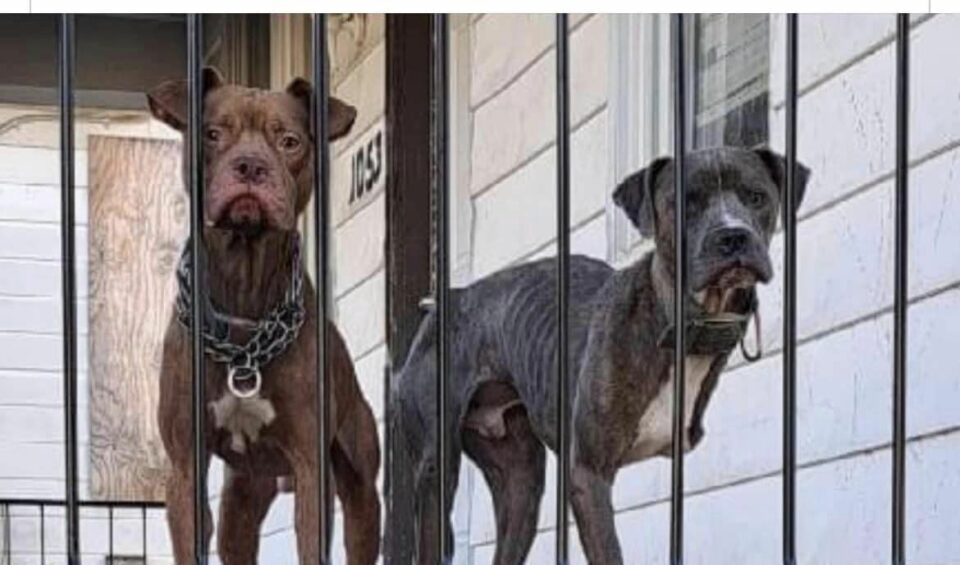
As soon as the neighbors in Price Hill, Ohio, saw the two dogs, Sampson and Boss, desperately waiting on the porch, they realized that their owners left them behind.
One of the abandoned pups was a tripod, and both of them were so malnourished that all their ribs could be seen.
The sad dogs were waiting for someone to help them.
After the concerned neighbors fed the canines, they started posting about them on Facebook and pleading for help.
Many shelters were overcrowded and refused to take them in.
Luckily, Rescue Me Animal Advocacy, a foster-based rescue in Clermont County, Ohio, was tagged in the Facebook posts.
After the rescue staff saw the sorrowful and neglected dogs, they were left brokenhearted.
They decided to take them in, although they usually don’t rescue dogs from that area. They couldn’t leave them to their luck.
The Pups Are Safe And Warm
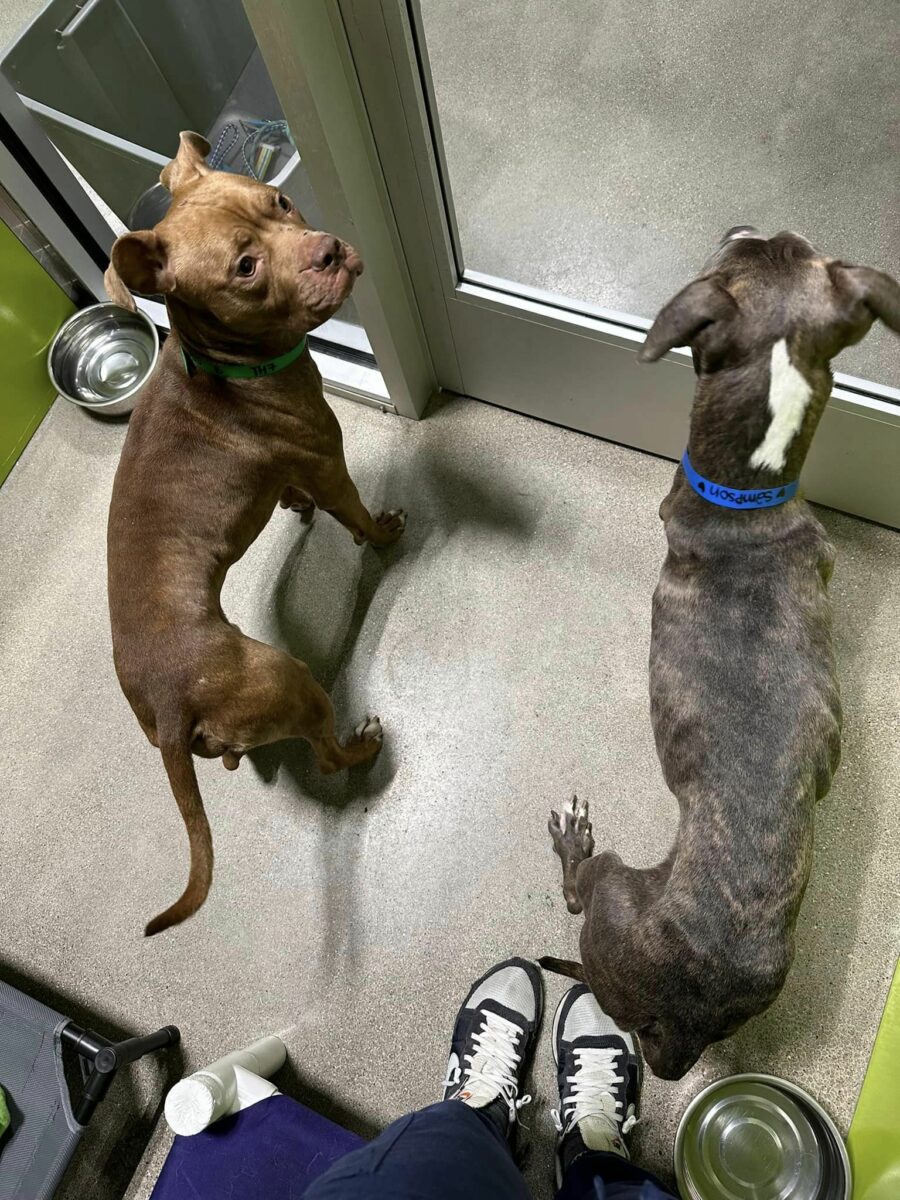
The good people took them to a vet, where they were given a medical examination.
The rescue got Boss and Sampson settled at PetSuites Mason, a boarding facility, and they are still funding their stay there.
When the canines arrived at the facility, the staff was sad to see the terrible state they were in. Sampson and Boss were skin and bones.
Since the dogs’ feelings were hurt, the staffers knew that the canines would need time to trust people again and open their hearts to love.
The kind-hearted people gave Sampson and Boss all the affection and care that they needed.
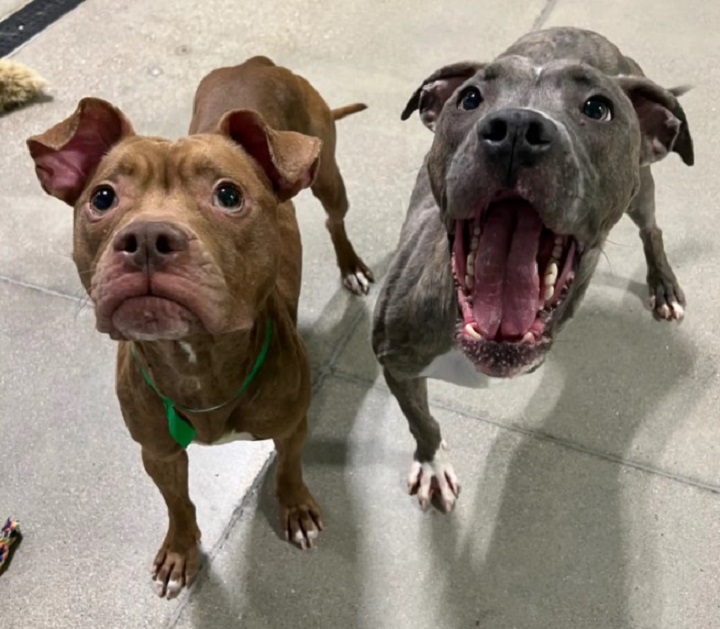
The canines began feeling relieved to be in a warm place where they had regular meals. Little by little, the pups started trusting their caregivers and revealing their wonderful personalities.
Sampson turned out to be a love bug. He enjoys cuddling in his human friends’ laps.
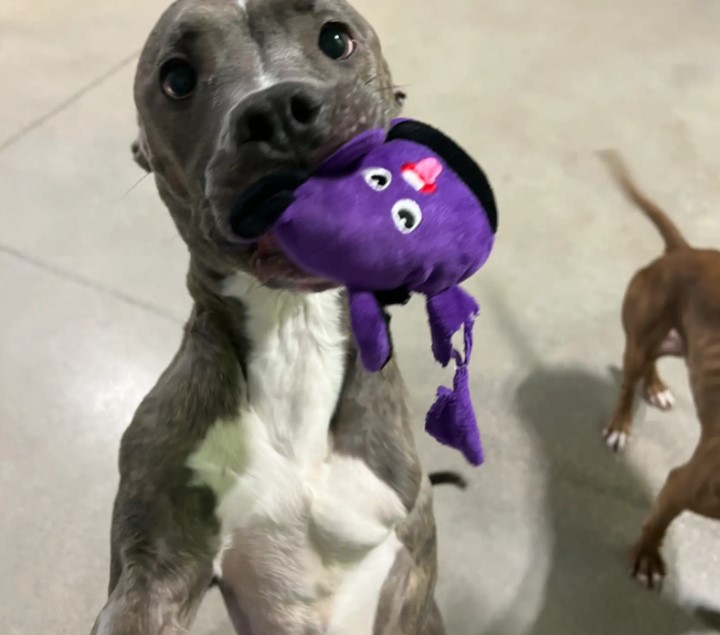
Boss was shy when he arrived at the facility. Now, the wonderful pooch has gained confidence, and he loves adventures.
Both brothers are adorable and full of love. The more time the staff spent with Boss and Sampson, the more they fell in love with them.
Although the pups appreciate the affection and care that they receive at the facility, it’s not the same as a real home.
Dreaming About Finding True Love
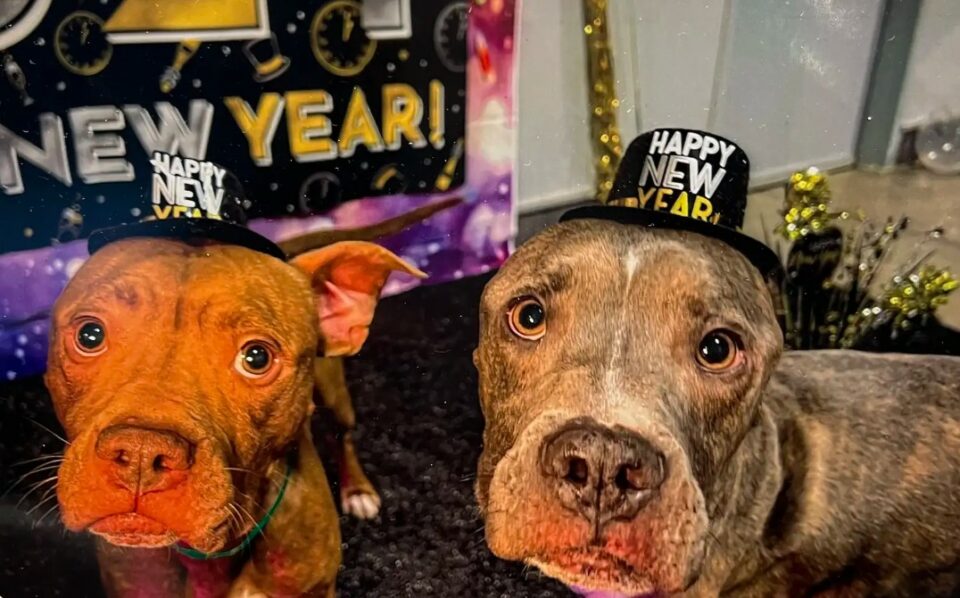
The sweet doggos dream of meeting their forever parents, running into their arms, and starting a new life filled with love.
“They look so much better now, so much healthier, but, unfortunately, we cannot find them a home,” Kim Bush, president of Rescue Me Animal Advocacy, told The Dodo.
Sampson and Boss bonded a lot because they went through a lot together. The furry brothers would be happiest if they could be adopted together, but they can also be adopted separately.
We hope that Sampson and Boss will soon find amazing parents who will give them all the love they long for.
If you’ve ever dreamed of having a furry companion but struggled with allergies, the world of hypoallergenic dogs might just be your answer. These special breeds are known for producing fewer allergens, making them a popular choice for those with sensitivities. Imagine cuddling up with a four-legged friend without the sneezing and itching – that’s the magic of hypoallergenic dogs.
Understanding Hypoallergenic Dogs
If you often find yourself sneezing or itching around dogs but still crave a furry friend, hypoallergenic dogs could be the ideal choice for you. These special breeds are known for producing fewer allergens, making them a great option for allergy sufferers. Here’s what you need to know about these unique companions:
Limited Shedding
Hypoallergenic dogs shed less compared to other breeds. This reduced shedding means there’s less dander (dead skin cells) distributed in the air, helping to minimize allergic reactions.
Low Dander Production
Dander is a common allergen for many people. Hypoallergenic dogs produce lower levels of dander, reducing the chances of triggering allergies in sensitive individuals.
Allergy-Friendly Coats
The coat types of hypoallergenic dogs play a significant role in reducing allergic reactions. Their hair, rather than fur, can be less irritating to allergies, as it doesn’t shed as much or release as many allergens.
Regular Grooming
While hypoallergenic dogs may shed less, they still require grooming to maintain their coat and skin health. Regular grooming can help further reduce the risk of allergic reactions by keeping dander at a minimum.
Compatibility with Allergy Sufferers
Hypoallergenic dogs are not allergen-free, but they can be a better match for individuals with allergies. Before bringing home a hypoallergenic pup, spend time with the specific breed to see how you react and ensure a good fit for your allergies.
Consultation with a Veterinarian
If you have severe allergies, consult with a veterinarian or allergist before getting a hypoall dog. They can provide guidance on choosing the right breed and offer tips for managing your allergies around pets.
Choosing a hypoallergenic dog can bring the joy of pet ownership without the discomfort of allergic reactions. By understanding what makes these breeds different, you can make an informed decision and enjoy the companionship of a furry friend without the sneezing fits.
Factors to Consider When Choosing a Hypoallergenic Dog
When deciding to bring a hypoallergenic dog into your home, there are a few key factors you should consider to ensure a harmonious relationship with your new furry friend.
Coat Type:
Choose a dog breed with a coat that produces less dander and sheds minimally. Breeds like Poodles, Bichon Frises, or Maltese are good options due to their low shedding and minimal dander production.
Grooming Needs:
Hypoallergenic dogs require regular grooming to maintain their coat and skin health. Make sure you’re prepared for the grooming responsibilities that come with these breeds, including brushing, bathing, and clipping.
Allergy Testing:
Before bringing a hypoallergenic dog home, consider getting allergy tested to confirm that you’re not allergic to specific breeds. This precaution can help prevent any unwanted allergic reactions once your new companion is home.
Consultation with a Professional:
Consulting with a veterinarian or allergist is vital, especially if you have severe allergies. They can provide guidance on the best hypoallergenic breeds for your specific allergies and offer tips on managing allergies while living with a canine companion.
Lifestyle Compatibility:
Consider your lifestyle and make sure it aligns with the needs of the hypoallergenic breed you choose. Some breeds may require more exercise or have specific behavioral characteristics that you need to accommodate.
Adoption vs. Purchase:
Whether you choose to adopt a hypoallergenic dog from a shelter or purchase from a breeder, ensure that the dog receives proper care and attention. Adopting can be a rewarding experience as you provide a loving home to a dog in need.
Training and Socialization:
Invest time in training and socializing your hypoallergenic dog to ensure they adapt well to their new environment and interact positively with people and other animals.
Regular Vet Check-ups:
Once you bring your new hypoallergenic dog home, schedule regular vet check-ups to monitor their health and address any concerns promptly.
Consider these factors carefully to make an informed decision and enjoy the companionship of a hypoallergenic dog without experiencing allergy-related issues.
Popular Hypoallergenic Dog Breeds
When choosing a hypoallergenic dog, it’s essential to consider specific breeds that are known for being more compatible with allergy sufferers. Here are some popular hypoallergenic dog breeds that you may want to consider:
- Poodle: Known for their intelligence and hypoallergenic coat, Poodles come in different sizes, making them versatile for various living situations.
- Labradoodle: A cross between a Labrador Retriever and a Poodle, Labradoodles are friendly, smart, and often hypoallergenic due to their Poodle ancestry.
- Maltese: These small dogs have a silky white coat that sheds minimally, making them a good choice for individuals with allergies.
- Portuguese Water Dog: Originally bred to assist fishermen, Portuguese Water Dogs have a non-shedding coat that is considered hypoallergenic.
- Schnauzer: With a distinctive beard and eyebrows, Schnauzers come in different sizes and are known for their low-shedding coats.
- Bichon Frise: These fluffy white dogs have a curly coat that produces less dander, making them suitable for allergy sufferers.
- Yorkshire Terrier: Yorkies have a long, silky coat that is hypoallergenic, although regular grooming is necessary to prevent matting.
Choosing a hypoallergenic dog from these popular breeds can help minimize potential allergic reactions and enhance your overall experience as a dog owner.
Tips for Managing Allergies with Hypoallergenic Dogs
When considering hypoallergenic dogs to manage allergies, there are a few essential tips to help you make the most of your pet ownership experience:
Brush Your Dog Regularly
Keeping your hypoallergenic dog’s coat clean and well-groomed can significantly reduce allergens in your home. Regular brushing helps remove loose hair and dander that can trigger allergies.
Wash Your Dog’s Bedding Frequently
Washing your dog’s bedding, blankets, and toys on a regular basis can help minimize allergens in your living space. Clean bedding means fewer allergens in the air, creating a healthier environment for both you and your furry friend.
Maintain a Clean Living Space
Regularly vacuuming carpets, rugs, and furniture can help eliminate allergens like pet dander that may trigger allergies. Using a HEPA filter vacuum cleaner can be particularly effective in reducing allergens in your home.
Bathe Your Dog Appropriately
Bathing your hypoallergenic dog with a gentle, hypoallergenic shampoo can help reduce the amount of dander on their skin and coat. However, be mindful not to over-bathe your dog, as this can strip their skin of essential oils.
Visit the Vet Regularly
Regular check-ups with your veterinarian are essential to ensure your hypoallergenic dog stays healthy and happy. Your vet can provide advice on managing allergies, recommend suitable grooming practices, and address any health concerns.
By following these simple tips, you can effectively manage allergies with your hypoallergenic dog and enjoy a harmonious relationship with your furry companion.
Conclusion
You’ve learned about the benefits of hypoallergenic dogs and how they can make a great choice for allergy sufferers. With breeds like Poodles, Labradoodles, Maltese, and more, there are plenty of options to consider. Remember, regular grooming, clean living spaces, and vet check-ups are key to keeping allergies at bay. By following these tips, you can enjoy the company of a hypoallergenic furry friend without the worry of allergies getting in the way.
Frequently Asked Questions
Are hypoallergenic dogs suitable for allergy sufferers?
Yes, hypoallergenic dogs can be suitable for allergy sufferers because they produce fewer allergens and are less irritating to allergies compared to non-hypoallergenic breeds.
What factors should I consider when choosing a hypoallergenic dog?
Consider the size, energy level, grooming requirements, and temperament of the dog in addition to its hypoallergenic qualities when choosing a breed to fit your lifestyle.
What are some popular hypoallergenic dog breeds?
Popular hypoallergenic dog breeds include Poodles, Labradoodles, Maltese, Portuguese Water Dogs, Schnauzers, Bichon Frises, and Yorkshire Terriers.
How can I manage allergies with a hypoallergenic dog?
You can manage allergies with a hypoallergenic dog by regularly brushing the dog’s coat, washing their bedding frequently, maintaining a clean living space, bathing them appropriately, and scheduling regular vet visits.
How can I ensure the health and happiness of my hypoallergenic dog?
To ensure the health and happiness of your hypoallergenic dog, provide them with proper grooming, exercise, nutrition, training, and affection, along with regular veterinary check-ups.
[no_toc]

Hey there, I’m Janet Brooks, a dog-loving student from California. I’m all about helping pups in need, especially those without homes. Me and my awesome friends work together to give shelter and love to stray dogs. Oh, and I also write blogs about dogs to share helpful info.